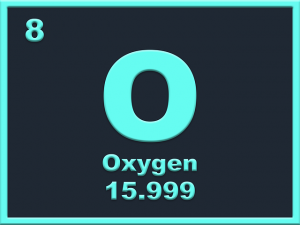Greetings to all!
 As we all know, Oxygen (O2) is perhaps one of the most important elements on the Earth!
As we all know, Oxygen (O2) is perhaps one of the most important elements on the Earth!
Human beings and all living organisms need oxygen both for generating and for maintaining all life processes. The deficiency of oxygen in the human body and in its environment is as harmful and destructive as its surplus.
Talking about humans, if they suffer from lack of oxygen, they will simply breathe more often, as they can! However, the Earth’s atmosphere cannot breathe in the deficient oxygen, it can only endure for a long time and get deteriorated.
Today I want to discuss only one of the oxygen aspects, namely its balance in the Earth’s atmosphere.
“The whole history of mankind is connected with consumption, or in other words burning of oxygen, and as long as things develop, this process is even accelerated and the volumes nothing but increase!”
We’ve heard such saying thousands of times, but did we try to answer honestly the specific questions? Among them:
– How much oxygen is there in the Earth’s atmosphere?
– How much oxygen exactly is consumed by humans within their life’s activities?
– Can oxygen simply expire?
– What to do in case of deficiency of oxygen?
So, let’s begin!
Our atmosphere consists of the following elements:
– oxygen: 20%
– nitrogen: 79%
– other gases, among them: carbon dioxide, hydrogen, ozone, methane and 10 more gases: 1% approx.
 The quantitative and percentage ratio of these elements differs in the course of our civilization development due to various factors, such as:
The quantitative and percentage ratio of these elements differs in the course of our civilization development due to various factors, such as:
– humans burn 3.5 million tons of oil per day;
– humans burn 4 billion m3 of natural gas per day;
– humans use other types of energy resources (coal, shale, peat, even firewood).
All these processes are conducted along with burning of oxygen!
The following changes have occurred in the atmosphere over the past 50 years:
– supply of oxygen in the atmosphere decreased in 4%, that is, down to 16%;
– atmospheric pressure decreased from 760 mm Hg (as of 1950) to 746 mm Hg (as of 2020);
– the scale height decreased from 100 km to 80 km.
(Specific details and basic data can be find here:
(https://www.tendencias21.net/El-nivel-de-oxigeno-en-la-atmosfera-ha-caido-lentamente-en-los-ultimos-800-000-anos_a43270.html, https://www.bbc.com/news/science-environment-50690995, https://habr.com/ru/post/409891/)
The above figures make it obvious: the assumption that oxygen can simply expire does not look fantastic. According to scientists, the irreversible process of critical oxygen loss in our atmosphere is on fast-forward!
(http://www.dopotopa.com/smogut_li_ludi_dyshat_cherez_100_let.html https://habr.com/ru/post/369705/)
 Within the last 50 years (since 1970) we burn 10,000,000,000 tons of oxygen from the Earth’s atmosphere annually due to development of production and use of hydrocarbons.
Within the last 50 years (since 1970) we burn 10,000,000,000 tons of oxygen from the Earth’s atmosphere annually due to development of production and use of hydrocarbons.
If it continues at this pace, by 2040 everyone on the Earth, I emphasize, EVERYONE will face a shortage of oxygen. This is our common disaster in the full sense of this word: for every country, every continent, every nationality and every live creature on the Earth!
What can be done? Measures on implementing green technologies in the energy sector, reducing use of aerosols, switching to electric cars and planting forests surely help to manage this problem. But they are visibly not enough!
Specifically, to compensate the oxygen burnt (10,000,000,000 tons per year, as it is stated above), one needs to plant 100/100 km2 of forests: and not whatever forests, but forests with maximum oxygen productivity.
FYI:
Tropical Amazon Rainforests produce only 10% of the world’s oxygen, the global ocean does 2%, and relict Boreal Forests (Taiga) release 50-70% of the oxygen received during photosynthesis.
On the other hand, how long will these forests grow: for 20-30 years?! We do not have so much time!
Modern technologies that directly enrich our atmosphere with oxygen in large volumes and with zero energy costs are desirable.
A group of entrepreneurs and scientists from Spain, the company “LIBRE EVOLUCION DE ENERGIA SL (https://free-libre.com/ru/) and the University of Málaga (UMA) (https://www.uma.es/),, have developed a technology that can radically solve the problem of oxygen (O2) deficiency in the atmosphere and compensate excessive CO2 emissions.
They designed and tested the window-façade system “FREENERGY”. The idea of this technology is in window that supports the photosynthesis reaction and enriches houses, offices and industrial premises with oxygen, using only solar energy for this purpose (https://free-libre.com/ru/freenergy/).
In the end of 2019, the University of Málaga ran a series of experiments to determine the quantitative metrics of the described process
(https://free-libre.com/wp-content/uploads/2020/04/SECARTYS_35_page_22.pdf),
(https://free-libre.com/wp-content/uploads/2019/04/Article_Feb.jpg).
The main result of these studies is, as follows:
A “FREENERGY” window of 1 m2 produces and releases 613.2 grams (0.6132 kg) of pure oxygen (O2) per year to the Earth’s atmosphere!
How can we apply these results to solve the problem of oxygen deficiency?
First, let’s make these results more understandable and visible.
One of our previous articles “How Many Windows are in Manhattan” (https://free-libre.com/ru/skolko-okon-na-manhettene/), we described interesting facts about this unique place.
The area of Manhattan Island is 59.1 km2.
The area of the Earth is 510 million km2.
According to the above-said data, the oxygen deficit is 10,000,000,000 tons per year, or, basically, 19.6 tons per year per 1 m2 of the Earth’s surface. Thus, the oxygen deficit in Manhattan is 1,158.9 tons per year (1,158,000 kg).
How many square meters of “FREENERGY” windows are required to compensate this shortage?
1,158,000 kg: 0.6132 kg = 1,889,426 m2
There are 10.7 million windows in Manhattan (https://www.computerworld.com/article/2980236/solar-windows-poised-to-change-the-way-we-power-buildings.html).
Assume that each window has an area of 1 m2, although the real size of the windows is larger, but we shall use this indicator to measure objectivity of our example. It sums up to 10.7 million m2 of windows.
Simple calculations show that even if 17.6% of Manhattan buildings have “FREENERGY” windows, then the oxygen deficit in Manhattan will be fully compensated!
Consider this: not a third or a half, but only 17.6% of the total number of windows! This is not a big deal, isn’t it?
Certainly, Manhattan is a special place! Nevertheless, our entire Earth consists of such special places; it is remarkable and unique itself. Let’s develop new technologies that help protect and sustain our home, OUR EARTH, for us and our future generations!
Best regards,
Alexander Kobtsev

